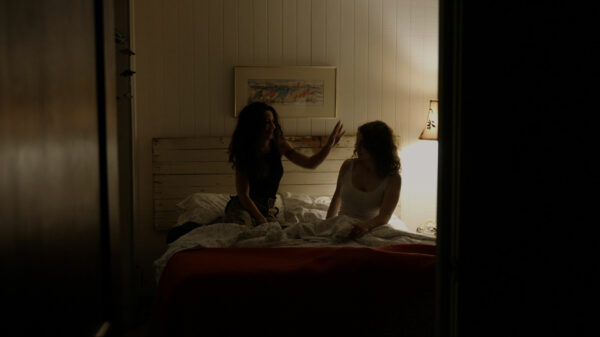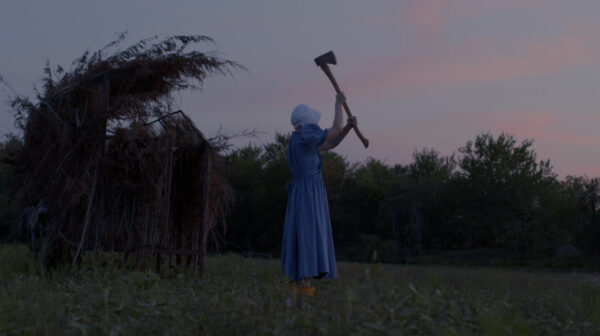The Dark Sisters (2023), directed by Texas filmmaker Richard Bailey, follows two sisters, Jorie and Kaidon, who reconnect at a secluded house surrounded by forest and bayou. They share a secret that has formed a wedge between them over the years, and soon discover that secret is to be judged by the omniscient authority of the nature around them. This authority seems to control the balance of our world’s constant churn of good and evil, and it must assess the sisters’ morality and mortality on a scale much larger than the institutions of justice that we, as humans, have created for ourselves.
The film begins in typical Bailey fashion, with a voice-over narration, separating the words from the world and illustrating our perceived disconnect from the natural world, as if the film were operating under a different set of rules. These voice-overs remain prevalent throughout the film, often taking over at unexpected times.
At first, I didn’t like it. I felt as though each voice-over was a cheap way to tackle a character’s obstacle. It wasn’t until almost halfway through the film that these words, which seemed to spring up from nowhere and bounce around in my head, began to weave through the images and refute me. I realized these obstacles weren’t physical. They didn’t need to be discussed between the characters. They belong to all of us, like a crime scene in our heads. What first seemed like rambling eventually morphed into a verbal search for answers, but every clue can send you in a different direction. The mystery of our existence remains a cold case.
Still, Bailey continues the search. He connects us back to the natural world through a dreamlike lens. Sitting on a screened-in porch or a dock next to the bayou, the sisters dissect their lives together, including their secret and its consequences. Jumping back and forth in time, guided by these conversations, we experience their past, see its effects in the present, and get a glimpse of the trajectories of their futures.
These conversations seemed a bit clunky and long-winded on the surface, but as the macabre nature of the film became more apparent, I started to see the resemblance to works by Edgar Allen Poe and H.P. Lovecraft. It often felt as if a poem or story from the past had been dropped into a modern setting. While it may not be the most natural dialogue, the content hits at the core of our basic human desire to know. So, fittingly, Bailey places a secret in the plot of the film, but behind it is that which we all seek to know: the secret of the universe.
Our vocabulary can only go so far, though. It’s when the film leaves these conversations behind that it gets the closest to this hidden truth of the universe. Like in a dream, often times you may not understand the situation you’re in, but you feel it. These almost-abstract sequences of the film don’t present horror, but elicit it. Bailey takes that which normally makes us uncomfortable: masks and murder, the deep forest, unearthed secrets, and places them out in the open so we can consider their origin. It’s like reverse horror. We’re given a chance to look at our nightmares as if they were on display at PetSmart. Then, we glance around, hoping no one noticed we were staring into a mirror. Any horror film might prick at you, but the one that leads you to tapping into what scares you, as an individual, has a lasting effect.
So, in the process of trying to understand what’s happening on screen, an avenue opens up for us to try to understand ourselves. The introduction of two other characters, who seem to shapeshift in their significance over the course of the film, adds another layer to this interpretive process. They essentially emerge from the forest and, eventually, each split off with one of the sisters. One is a pastor, the other a thief. Perhaps these characters represent each sisters’ perception of themselves, or their opposing forms of coping, in relation to the secret of their past. They appear to be embodiments of good and evil. But what if, in this case, both good and evil are just misinterpretations of survival?
Then comes the introduction of the fifth and final character, who seems to be the voice of the forest. She mediates justice but causes collateral damage, inevitably holding the scale that teeters the lives of the sisters. Here we see that that the grand orchestration of the sisters’ lives may not be individual-oriented. They share something more than just DNA or a secret. It’s something that binds them inextricably. Something unknown.
The Dark Sisters reminded me that I can dream without sleeping. Although I thought the moment in the film that came closest to capturing that feeling of the unknown, a warped handheld shot moving through the forest, was cut much too short, I was given a chance revisit it. As the camera slowly glides over a bayou, we are asked to consider what’s under the surface. Why did that particular moment resonate with me?
In my dream, I’m walking through a forest not unlike the one in the film. It’s night and all I have with me is a two-way radio. I check every channel, all completely static except for one. Each time I speak, someone responds, but I can’t make it out. I keep walking, using the radio frequency like a compass. I’ll know I’m headed in the right direction when I hear the voice clearly. I go on and on through the trees and never get tired. The frequency never changes. I begin to think we’re both walking in the same circle on opposite ends.
At times, The Dark Sisters felt almost interactive. There are gaps to fill in and theories to be considered, not only in the characters’ lives but in our own. After all, the mystery belongs to all of us. Taking form as a collage rather than a conventional story, this film is made up of layers of ideas, images and sounds, still photography and dance, and even animation. These mediums all lend themselves to the same cause: to encourage us to pull the cold case out of its file and look at it from a new angle.
The Dark Sisters will be released later this year through its distributor, BayView Entertainment. The trailer for the film can be seen here.






1 comment
What a thoughtful review of the film. Bailey’s films are complex and always leave me with more questions than answers. But doesn’t great art do that? The landscape is a dominant character in his films and I appreciate what you said about nature as the omniscient authority. Also to think about the film as a collage, rather than a traditional narrative is helpful in letting go of expectations with regards to film structure and narrative.